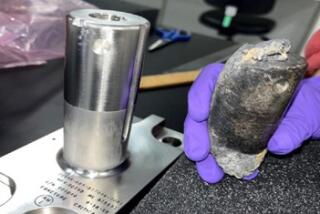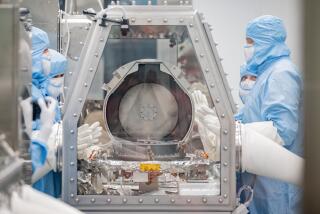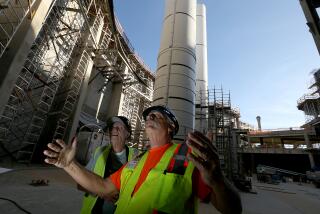Space Station Gets a Boost from Atlantis Astronauts
- Share via
Two astronauts from the shuttle Atlantis attached new hardware to the International Space Station on Tuesday and inadvertently added to the floating garbage dump that surrounds Earth when a bolt floated away from their zero-gravity construction site.
“I just hope that bolt is on its way to Mother Earth” and not in an orbit that could bring it back and hit the station, said astronaut Joe Tanner, who was trying to attach the bolt when it jerked loose, along with a spring and washer, and drifted away.
Several thousand pieces of space junk orbit Earth and are considered such a potential danger to spacecraft that the larger pieces of flotsam are constantly monitored, just like satellites.
NASA officials tried to assuage Tanner’s worry. “We have evaluated the risk, and at this point we are not concerned about it,” said Kirk Shireman, a spokesman for the International Space Station.
The errant 2-ounce bolt was the only glitch in an otherwise flawless performance by spacewalkers Tanner and Heidemarie Stefanyshyn-Piper, who spent more than six hours in space connecting a 17.5-ton truss and its attached solar arrays to the station. Altogether, they connected 13 wires and tubes and adjusted 167 bolts.
“It was an outstanding day on orbit. The berthing went exactly as planned,” Shireman said.
More good news came when the high-level Mission Management Team meeting at Johnson Space Center in Houston cleared Atlantis as safe to return to Earth next week. The clearance came after engineers spent 60 hours looking at film and radar images of the launch.
Two potential problems cropped up: a piece of plastic protruding between two heat-resistant tiles, and a piece of a thermal “blanket” sticking out near an engine used to adjust the spacecraft’s orbit. Neither issue will cause problems for reentry, NASA said.
“Overall, Atlantis is performing extremely well,” said John Shannon, management team chairman.
NASA implemented an extensive set of review procedures for the shuttle’s heat shield after the 2003 crash of Columbia. The craft was damaged during launch by a piece of insulating foam that sloughed off the external fuel tank and hit the left wing. Neither NASA nor the crew realized it, and the orbiter broke up when it reentered Earth’s atmosphere.
Installation of the truss, a piece of the station’s spine to which laboratories will be attached later, was the first construction work on the space station since the Columbia accident. The attached solar arrays will double the amount of power the station can produce.
The arrays are to be unfurled to their full 240-foot length Thursday.
*
More to Read
Sign up for Essential California
The most important California stories and recommendations in your inbox every morning.
You may occasionally receive promotional content from the Los Angeles Times.













